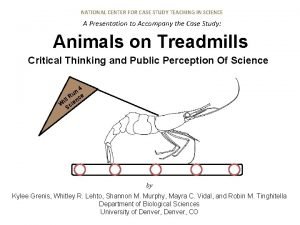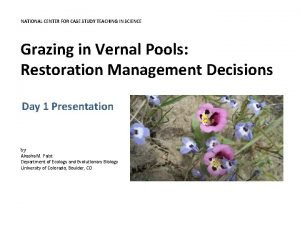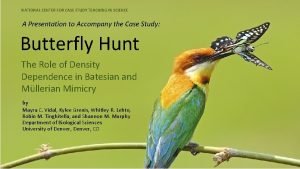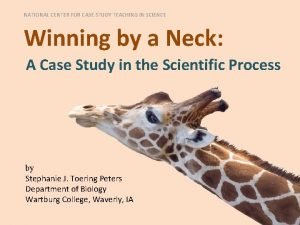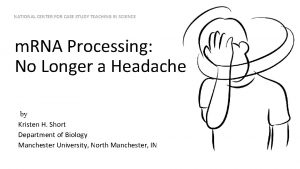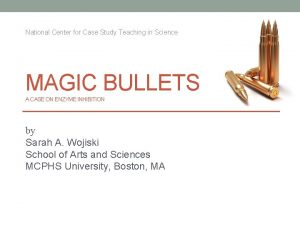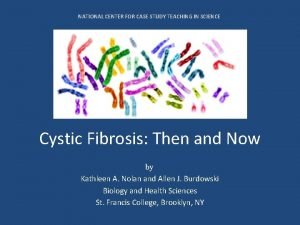NATIONAL CENTER FOR CASE STUDY TEACHING IN SCIENCE



















- Slides: 19

NATIONAL CENTER FOR CASE STUDY TEACHING IN SCIENCE Scorpion vs. Mouse: A Tale of Venom and Action Potentials by Justin F. Shaffer Department of Chemical and Biological Engineering Colorado School of Mines, Golden, CO

Learning Objectives • Compare and contrast the structures and functions of neurons and glia. • Explain how ion channels contribute to membrane potential. • Explain how action potentials are generated and propagated. • Predict how membrane potential and action potentials may be altered by foreign substances. 2

Arizona Bark Scorpion Southern Grasshopper Mouse Lives in Sonoran Desert of US Southwest. Most venomous scorpion in North America. Intense pain for 24 – 72 hours in humans. http: //www. sciencemag. org/news/2013/10/mouse-impervious-scorpions-sting 3

When mice feel pain on a part of their body, they lick that part Experiment: Researchers injected bark scorpion venom into the hind paws of the common house mouse and the southern grasshopper mouse; As a control, they injected 0. 9% saline solution. Then they measured how long they licked their paws afterwards. What data do you think they observed? House Mouse Southern Grasshopper Mouse 4

CQ 1: What data do you think they observed? 5

House mouse Grasshopper mouse How is this possible? 6

Can you label this image? CQ 2: What is true about this image? A – The image shows a neuron and glia. B – The image shows only a neuron. C – The image shows only glia. Synaptic terminal Dendrite A Schwann cell Cell body E B C Nucleus CQ 3: Action potentials travel through which structure? F D Axon 7

CQ 4: What is the major contributor to a neuron’s resting membrane potential of -60 to -80 m. V? A – Diffusion of sodium ions through ungated sodium channels. B – Diffusion of potassium ions through ungated potassium channels. C – Diffusion of sodium ions through voltagegated sodium channels. D – Diffusion of potassium ions through voltagegated potassium channels. 8

1. What components are shown in this figure? 2. Which side has more potassium ions? More sodium ions? 3. Which side is more negatively charged? Positively charged? Extracellular Intracellular 9

Sodium ion (Na+) Potassium ion (K+) Ungated sodium Ungated potassium channel Extracellular + + + + _ _ _ _ Intracellular More positively charged ions are leaving the cell than are coming in, so there is a net negative charge inside the cell. 10

CQ 5: What would happen if this ungated sodium channel was blocked? A – The neuron would hyperpolarize. B – The neuron would depolarize. Hyperpolarization – membrane potential becomes more negative. Depolarization – membrane potential becomes less negative. What happens if a neuron depolarizes such that it reaches threshold? 11

What happens in each phase of an action potential? Membrane potential (m. V) 50 Now we are talking about voltage gated channels and NOT ungated channels! 3 0 4 -50 Threshold 1 2 5 -100 Time 12

CQ 6: In what stage do voltage-gated Na channels begin to open? A – Stage 1 B – Stage 2 C – Stage 3 D –Stage 4 E – Stage 5 Threshold 13

CQ 7: In what stage do voltage-gated K channels begin to open? A – Stage 1 B – Stage 2 C – Stage 3 D –Stage 4 E – Stage 5 Threshold 14

1 – Resting state 2 – Depolarization 3 – Rising phase 4 – Falling phase 5 – Undershoot Membrane potential (m. V) 50 3 0 4 -50 Threshold 1 2 5 -100 Time 15

Experiment: Injected bark scorpion venom into mouse neurons and measured how many action potentials were generated after the venom was introduced CQ 8: Based on these data, what effect do you think the venom is having in the grasshopper mouse? A – The venom is only blocking voltage-gated sodium channels. B – The venom is only blocking voltage-gated potassium channels. C – The venom is opening voltagegated sodium channels or blocking voltage-gated potassium channels. D – The venom is opening voltage. House mouse Grasshopper mouse gated potassium channels or blocking voltage-gated sodium channels. These neurons transmit pain signals (action potentials) to the grasshopper mouse brain. What effect does the venom have on the grasshopper mouse? The venom blocks pain sensations in the grasshopper mouse. . 16

CQ 9: Which conclusion about the effects of venom on the grasshopper mouse is supported by these data? A – The venom is blocking voltagegated sodium channels. B – The venom is blocking voltagegated potassium channels. C – The venom is opening voltagegated sodium channels. D – The venom is opening voltagegated potassium channels. Can you explain why the grasshopper mouse is resistant to the bark scorpion venom? Fraction of sodium current Experiment: Injected increasing amounts of bark scorpion venom into mouse neurons and measured the flow of sodium ions (current) across the cell membrane. House mouse Grasshopper mouse 17

There are two missense mutations in a specific voltage-gated sodium channel in the grasshopper mouse! The venom binds to the mutant sodium channel and blocks its function. E 859 Q and Q 862 E 18

Image Credits Slide 1. Photo of grasshopper mouse. This image is a work of a United States Department of Energy (or predecessor organization) employee, taken or made as part of that person's official duties. As a work of the U. S. federal government, the image is in the public domain. https: //commons. wikimedia. org/wiki/File: Grasshopper_mouse_HD. 16. jpg Slide 1. Photo of Bark Scorpion by Brian Basgen, CC BY-SA 3. 0. https: //commons. wikimedia. org/wiki/File: Bbasgen-scorpion-front. jpg Slide 3. Photo of house mouse by George Shuklin, CC BY-SA 1. 0. https: //commons. wikimedia. org/wiki/File: %D 0%9 C%D 1%8 B%D 1%88%D 1%8 C_2. jpg Slide 5. Modified Figure 1 A from Rowe et al. 2013 paper http: //sciencemag. org/content/342/6157/441 Slide 6. Figure 1 A from Rowe et al. 2013 paper http: //sciencemag. org/content/342/6157/441 Slide 7. Drawing of neuron by Quasar Jarosz, CC BY-SA 3. 0. https: //commons. wikimedia. org/wiki/File: Neuron_Hand-tuned. svg Slide 16. Modified Figure 3 C from Rowe et al. 2013 paper. http: //sciencemag. org/content/342/6157/441 Slide 17. Modified Figure 2 D from Rowe et al. 2013 paper. http: //sciencemag. org/content/342/6157/441 Slide 18. Modified Figures 6 A and 6 B from Rowe et al. 2013 paper. http: //sciencemag. org/content/342/6157/441 19
 National center for case study teaching in science
National center for case study teaching in science National center for case study teaching in science
National center for case study teaching in science National center for case study teaching in science
National center for case study teaching in science National center for case study teaching in science
National center for case study teaching in science National center for case study teaching in science
National center for case study teaching in science National center for case study teaching in science
National center for case study teaching in science National center for case study teaching in science
National center for case study teaching in science Best worst and average case
Best worst and average case Project failure case study
Project failure case study What is your favourite subject in college and why
What is your favourite subject in college and why Phases of microteaching
Phases of microteaching Fspos
Fspos Typiska novell drag
Typiska novell drag Nationell inriktning för artificiell intelligens
Nationell inriktning för artificiell intelligens Returpilarna
Returpilarna Varför kallas perioden 1918-1939 för mellankrigstiden?
Varför kallas perioden 1918-1939 för mellankrigstiden? En lathund för arbete med kontinuitetshantering
En lathund för arbete med kontinuitetshantering Adressändring ideell förening
Adressändring ideell förening Tidbok
Tidbok Anatomi organ reproduksi
Anatomi organ reproduksi


